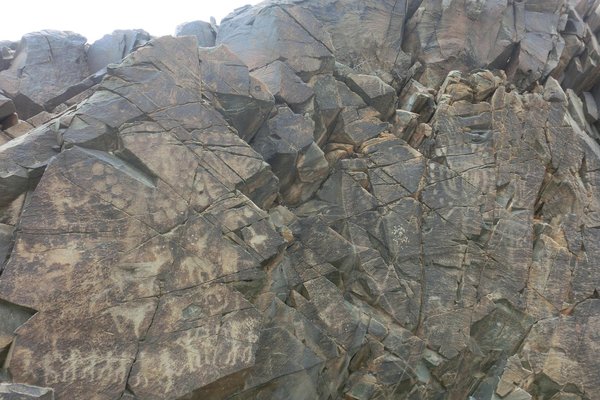Kazakhstan
Tanbaly
The Petroglyphs within the Archaeological Landscape of Tanbaly testify to the lives and beliefs of the people of the Central Asian steppe since the Bronze Age.
Tanbaly holds large petroglyphs, mostly cut into unsheltered rock faces, that are unique in their iconography. Over 5,000 images across 48 locations have been found. The site also includes ancient settlements, burial sites and sacred sites.
Community Perspective: situated in a remote location, only accessible via private transport. Make sure you or your driver/tour company doesn't confuse it with Tamgaly Tas. The rock engravings are signposted in 7 groups (not all might be open), and can be easily visited in 2 hours. Solivagant’s review zooms in on the cultic complex that they allegedly were part of. Els has provided the most recent overview of what you may expect to find on site.
Site Info
Official Information
- Full Name
- Petroglyphs of the Archaeological Landscape of Tanbaly (ID: 1145)
- Country
- Kazakhstan
- Status
-
Inscribed 2004
Site history
History of Tanbaly
- 2021: Name change
- From "Petroglyphs within the Archaeological Landscape of Tamgaly" to "Petroglyphs of the Archaeological Landscape of Tanbaly"
- 2004: Advisory Body overruled
- Referral was advised, because of lacking Management Plan
- 2004: Inscribed
- Inscribed
- Type
- Cultural
- Criteria
- iii
Links
- UNESCO
- whc.unesco.org
- Official
-
- tanbaly.kz — Reserve museum «Tanbaly»
- visitkazakhstan.kz — Tamgaly
- Related
-
- almadf.kz — Link
All Links
UNESCO.org
- whc.unesco.org — whc.unesco.org/
Official Website
- tanbaly.kz — Reserve museum «Tanbaly»
- visitkazakhstan.kz — Tamgaly
Related Resources
- almadf.kz — Link
Community Information
- Community Category
- Archaeological site: Rock Art
Travel Information
Recent Connections
-
Name changes
From "Petroglyphs within the Archaeolog… -
Built in the 2nd Millennium BC
"The Tamgaly type engravings date from … -
Tumuli
"A huge number of ancient burials are k…
Connections of Tanbaly
- Geography
-
-
Canyons
the Chu-Ili mountain spur forms a canyon around the Tamgaly Gorge (AB ev)
-
- History
-
-
Iron Age
Some petroglyphs date from the Early Iron Age and were made by Sakae, Wusun peoples (AB ev) -
Bronze Age
"a substantial testimony to the lives and beliefs of pastoral peoples of the central Asian steppes from the Bronze Age to the present day." (OUV)
-
- Ecology
-
-
Sandstone Formations
"The site on sandstone rocks is vulnerable to weathering" (AB ev)
-
- World Heritage Process
-
-
Inscribed on a single criterion only
iii. to bear a unique or at least exceptional testimony to a cultural tradition or to a civilization which is living or which has disappeared
-
- Human Activity
-
-
Pastoralism
testimonies to the husbandry, social organization and rituals of pastoral peoples (AB ev) -
Petroglyphs
"features a remarkable concentration of some 5,000 petroglyphs" (OUV) -
Stone Quarries
"Ancient quarries are found associated with the Bronze Age cemeteries – providing the large stone slabs used in the construction of costs." (AB ev)
-
- Constructions
-
-
Cemeteries
Several Bronze Age burial grounds, including graves consisting of stone boxes -
Tumuli
"A huge number of ancient burials are known on the site. ... the later types consist of mounds (kurgans) of stone and earth built above tombs. The latter seem to date from the Early Iron Age to the present day." (AB ev) -
Cenotaph
The Tamgaly II burial ground (Bronze Age) includes "symbolic graves (cenotaphs) without remains of people" (according to sign at the site).
-
- Timeline
-
-
Built in the 2nd Millennium BC
"The Tamgaly type engravings date from the second half of 14th and 13th century BC." (AB ev)
-
- WHS Names
-
-
Name changes
From "Petroglyphs within the Archaeological Landscape of Tamgaly" to "Petroglyphs of the Archaeological Landscape of Tanbaly" (2021)
-
News
No news.
Recent Visitors
Visitors of Tanbaly
- Alexander Barabanov
- Atila Ege
- BaziFettehenne
- Bin
- Cirene Moraes
- David Marton
- del
- Els Slots
- Erik Jelinek
- Fan Yibo
- Feldhase
- Gernot
- henryjiao18
- Iain Jackson
- Ivan Rucek
- Jarek Pokrzywnicki
- Jonas Kremer
- Luis Filipe Gaspar
- Maciej Gil
- Martina Rúčková
- Mathijs
- Mihai Dascalu
- Mikko
- Milan Jirasek
- Naim Y
- Nihal Ege
- Remski
- Roman Bruehwiler
- Solivagant
- Szucs Tamas
- Tamara Ratz
- Tarquinio_Superbo
- Thomas Buechler
- Timothy C Easton
- Walter
- Westwards
- Xiquinho Silva
- Yevhen Ivanovych
- Zoë Sheng
Community Reviews
Show full reviews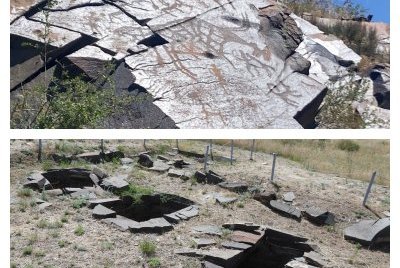
On a map, the Kazakh WHS of Tanbaly (not to be confused with Tamgaly Tas!) doesn’t look to be too far from Almaty, but it takes quite some time to cover the 170km between the two places (we did it in 2h45). I went with a car & driver which I’d hired for the day via Indyguide, and we first had to navigate the busy and chaotic traffic to get out of Almaty. Then there’s a good stretch of highway west and, after the turnoff to the north which is signposted to the Site of Tanbaly, what remains is a B-road with some potholes but little traffic. The only thing you see by the side of the road are large farms, and they keep sheep and horses as livestock. As so often with rock art sites, Tanbaly lies in a remote river canyon that once had special meaning for people living in or passing through the region but lost its significance later on. It’s also the only piece of exposed rock in an area of steppes and offers protection against the sun and wind.
Our first stop was at the museum, which was given a proper building in 2021 and even comes with a museum shop. They show a few findings from the site, such as pottery found in the graves. Otherwise, it is mostly large photographs of the rock art on display. They also explain how they cleared the rocks of graffiti, which has been a …
Keep reading 0 comments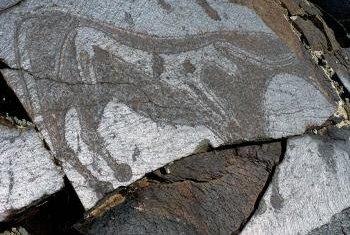
Of the 41 sites currently represented in our “Petroglyphs” Connection only 8, by my count, have been inscribed solely/mainly because of their rock art (Gobustan, Coa/S Verde, Mong Altai, Hail, Alta, Tanum, Valcamonica and Tamgaly). Tamgaly was the 6th of these which we have visited (missing Mong Altai and Hail). Looking back, and trying to discount both the “shock of the new” for the first ones and “travel excess/ennui” for some of the later ones, our view is that Tamgaly emerges pretty well in “interest terms” and significance compared with the others and contains some historically significant representations! It also introduces an archaeological period and culture which is not well known in W Europe/N America possibly because access to it by their archaeologists was cut off for political reasons
As previous reviews have stated, Tamgaly needs to be reached by car, probably from Almaty in a day return trip. We played a slight finesse on this and “saved” a day as we arranged for the vehicle taking us from the Kyrgyz border north of Bishkek to Almaty to take in Tamgaly “on the way”. The turn off north is almost exactly half way between the border and Almaty on National Highway A2 after around 1.5 hours in either direction – Tamgaly then lies another 1 hour along a deteriorating road reaching into ever emptier rolling steppe lands. At the (very) small village of Karabastay there is a visitor centre which neither our guide, archaeologist or driver thought ever opens …
Keep reading 0 comments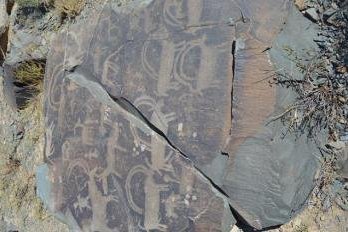
Tamgaly is the most striking site of rock arts in Central Asia; it is located about 125 km northwest of Almaty, and can be reached only by private transportation. There is no public bus going there, or even going to the villages nearby. I organized it with Stantours, the driver/tourguide (ask for Marat) was very knowledgeable, and is doing this trip on a weekly basis during the tourist season in summer.It is probably a good idea to travel with other people to reduce costs. To rent a car is another option, but you wont have a guide to explain the site. The total number of rock drawings is about 5,000, mainly scenes of goats, horses, warriors, animal sacrifices, and images representing the worshipped sun and their gods; there is even an erotic scene, most probably the first pornographic rock art worldwide, as most of the petroglyphs were made in the Bronze age about 3000 years ago. There is also a scene of dancing men with a woman giving birth. Some stones do have graffitis, unfortunately, or rocks were destroyed by human beings, and carried away. Others show signs of cracks, caused maybe by extreme differences in temperature, frost weathering, or by earthquakes that often occur in this region. The rock engravings are signposted in 5 groups, and can be easily visited in 2 hours. A few steps away, there is also a burial ground of the Turkic period which shows both mass burial, probably of a family with children, and …
Keep reading 0 comments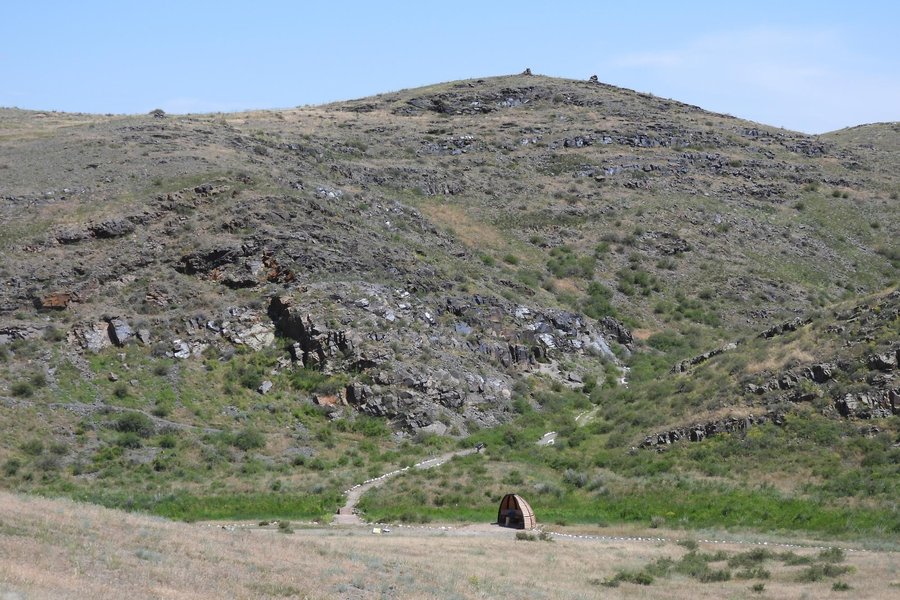
I visited the site at Tamgaly in October, 2005. There is very little security there and one spot looked as if someone had tried to cut one of the petroglyphs out of the rock-face. There was one soldier on guard at the site and that day we saw nobody else as we travelled to the site and returned to Almaty. It is fairly isolated. There was no description at the site except for a few old Russian signs. Things may have changed since then and I would like to know if it's a little more visitor-friendly. There was no entry fee and even my driver had trouble finding the place....he actually got lost a couple times along the way. The rock art is interesting but without a guidebook or a knowledgeable interpreter, it was hard to figure out what it all meant.
Keep reading 0 comments
